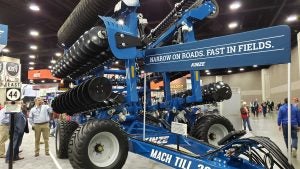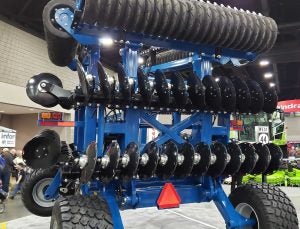Growers face countless safety hazards on and around their farms, and transporting machinery from field to field on public roadways is of particular concern. Kinze Manufacturing is making that task easier on its larger-end Mach Till implements with the addition of narrow-transport models in 30-, 36-, and 41-foot widths. When folded, the first two are just 13 feet, 2 inches wide, while the largest one is 16 feet wide.
These three new models, numbed 302, 362, and 412, provide more options and help split the horsepower requirements compared with some older tools, giving more flexibility based on working depth and speed while still maintaining at least 12 to 15 horsepower per foot. They join two smaller Mach Till models in Kinze’s lineup, the 201 and 261, which were already narrow transport.

All of the Mach Till models are what Kinze calls hybrid horizontal tillage, which can cover 30 to 60 acres per hour depending on the size of the tool. It makes quick work of a job and is built to be used for both fall and spring tillage — a new characteristic for some farmers who may not have had both capabilities in a single tool before.
“Come spring time, we want to be able to plant right behind this machine,” said Kinze Director of North America Sales Eric Broadbent, who is at the National Farm Machinery Show, Booth 4499 in the North Wing.
Go all in on #NFMS20 with our complete event coverage.
The Mach Till lineup has two rows of concave discs and a contoured rubber roller toward the rear. In the front row, many growers use a double-V blade, while the second row is typically a smooth blade.
The Mach Till “is slicing and sizing residue on the first cut and doing a little bit of mixing action as it sends soil and residue back to the second row, where it has a smooth blade. And from there, it does a lot more of the incorporation action,” Broadbent explained.
Operators can easily choose between deeper 5- or 5.5-inch depths or something shallower, like a 0.5- or 1-inch depth, which would be fitting for the more mellow soil that can often be found in the spring time.

The rubber roller at the back then plays a major part in system, helping to pin down the residue, so a wind or water event doesn’t force the residue to end up in a ditch or in a small corner of the field. The roller, which is contoured to facilitate the exchange of air and gas in the soil, helps to protect the nutrient value that residue gives to the soil.
“With what we’re doing with the front row and the second row of disc blades, you really eliminate a lot of the washboard effect that you might see from a conventional tandem disc,” he said. “It gives you more of that field-cultivator-type finish. And the rubber roller is the finishing tool.
Each Kinze Mach Till tool brings multiple technologies together into one implement, truly earning the hybrid moniker. The 302 is on display at Booth 4499 in the North Wing of the 2020 National Farm Machinery Show. More information is also available on Kinze’s website.
The article was published on behalf of Kinze.



